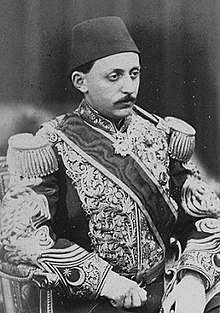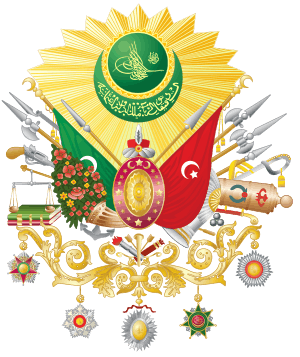Murad V
Murad V (Ottoman Turkish: مراد خامس) (21 September 1840 – 29 August 1904) was the 33rd Sultan of the Ottoman Empire who reigned from 30 May to 31 August 1876.
| Murad V مراد خامس | |||||
|---|---|---|---|---|---|
| Ottoman Caliph Sultan of the Ottoman Empire Kayser-i Rûm Custodian of the Two Holy Mosques | |||||
 | |||||
| 33rd Ottoman Sultan (Emperor) | |||||
| Reign | 30 May 1876 – 31 August 1876 | ||||
| Predecessor | Abdulaziz | ||||
| Successor | Abdul Hamid II | ||||
| Born | 21 September 1840 Istanbul, Ottoman Empire (present day Istanbul, Turkey) | ||||
| Died | 29 August 1904 (aged 63) Çırağan Palace, Istanbul, Ottoman Empire | ||||
| Burial | 30 August 1904 New Mosque, Istanbul | ||||
| Consorts | Mevhibe Kadın Reftarıdil Kadın Şayan Kadın Meyliservet Kadın Resan Hanım | ||||
| Issue | Şehzade Mehmed Selaheddin Hatice Sultan Fehime Sultan Fatma Sultan Aliye Sultan | ||||
| |||||
| Dynasty | Ottoman | ||||
| Father | Abdulmejid I | ||||
| Mother | Şevkefza Kadın | ||||
| Religion | Sunni Islam | ||||
| Tughra | |||||
Early life
Murad was born in Istanbul on 21 September 1840.[1] His father was Abdulmejid I. His mother, whom his father married in Constantinople on 1 August 1839, was Şevkefza Valide Sultan, an ethnic Circassian[2][3][4] from the Ubykh tribe, daughter of Mehmed Bey Zaurum and his wife Cemile Hanım.[5]
Beginning in late 1840, other princesses and princes of the young sultan were born. Attention was paid to the education and careful training of the great prince Murad. Among the teachers of the prince, his Quran teacher, Toprik Süleyman Efendi, Ferrik Efendi, Sheikh Hafız Efendi taught him Hadith (the traditions of Muhammad), Monsieur Gardet (French), and Italian Lombardi (piano).[6]
Murad also participated in the visits of Abdülaziz to Egypt in 1863 and to Europe in 1867. While he was appreciated by the European rulers with his kindness, his uncle, who was uncomfortable with this, had planned to send him back to Istanbul. Napoleon and Queen Victoria, showed interest in Murad more than Abdulaziz. Moreover, special invitations and excursions were organized for the crown prince.[7]
He spent most of his time at the farmhouse in Kurbağalıdere, Kadıköy, which Abdülaziz had allocated to him. He frequently spoke with Şinâsi, Nâmık Kemal and Ziyâ (Pasha) gentlemen about legitimacy, democracy and freedom. In Ziyâ Pasha and his special doctor, Kapoleon Efendi, he also communicated with Midhat Pasha, the leader of the opposition group, who was dissatisfied with Abdulaziz's rule. In this case, the Ottoman Empire faced various difficulties. [8]
Reign
Accession
He succeeded to the throne after the deposition of uncle on 30 May 1876. He was highly influenced by French culture and was a liberal.[9][10][11][12] He reigned for 93 days before being deposed on the grounds that he was mentally ill.[12] As a result, he was unable to deliver the Constitution that his supporters had sought. The ensuing political instability caused by his ousting moved the empire closer to the disastrous war with Russia, then ruled by Alexander II.
Murad V was the first and only Sultan member of the Grand Lodge of Free and Accepted Masons of Turkey.[13][14]
An important primary source about his life comes from the memoirs of one of his consorts, Filizten Kalfa, written in the 1930s.[15]
Death
He died at Çırağan Palace, Ortaköy, Istanbul, and was buried in Istanbul on 30 August 1904. His brother, Abdul Hamid II, ascended the throne on 31 August 1876.
While his wife Mevhibe and her son Selahaddin Efendi reported that Murad V was willing to be buried in Yahya Efendi Mausoleum, he did not approve of it. Abdulhamid removed his brother's funeral without announcement and ceremony. The prayer of the former sultan who was washed and shrouded in Topkapı Palace was performed in the Hidayet Mosque in Bahçekapı; After the funeral procession was held, he was buried next to his mother Şevkefza in the New Mosque, Istanbul. [16]
Family
Murad married five times and had five children. His marriages were:
- He married firstly at Istanbul, Beşiktaş, Beşiktaş Palace, on 2 January 1857 to Georgian Mevhibe Kadın (Tbilisi, 6 August 1835 – Şişli, 21 February 1936), daughter of Ahmed Bey Tarkanişvili, without issue.[17]
- He married secondly at Istanbul, Beşiktaş, Beşiktaş Palace, on 4 February 1859 to Circassian (from Abzakh tribe)[17] Reftarıdil Kadın (North Caucasus, c. 1844 – Istanbul, Ortaköy, Ortaköy Palace, 3 March 1936), daughter of Hatkoyuko Bey Hatko,[17] and had:
- Şehzade Mehmed Selaheddin (Dolmabahçe Palace, Istanbul, 5 August 1861 – Feneryolu Palace, Üsküdar, Istanbul, 29 April 1915 and buried in Şehzade Kemaleddin Mausoleum, Yahya Efendi), married and had issue;
- Şehzade Osman Fuad
- Şehzade Ahmed Nihad, married and had issue;
- Şehzade Ali Vâsib, married and had issue;
- Şehzade Osman Selaheddin Osmanoğlu, married and had issue;
- Şehzade Orhan Murad Osmanoğlu, married and had issue;
- Şehzade Selim Süleyman Osmanoğlu, married and had issue;
- Ayşe Gülnev Osmanoğlu, married and had issue;
- Şehzade Osman Selaheddin Osmanoğlu, married and had issue;
- Şehzade Ali Vâsib, married and had issue;
- Şehzade Mehmed Selaheddin (Dolmabahçe Palace, Istanbul, 5 August 1861 – Feneryolu Palace, Üsküdar, Istanbul, 29 April 1915 and buried in Şehzade Kemaleddin Mausoleum, Yahya Efendi), married and had issue;
- He married thirdly at Istanbul, Beşiktaş, Beşiktaş Palace, on 5 February 1869 to Circassian (from Natukhai tribe) Şayan Kadın (Anapa, Russia, c. 1854 – Ortaköy 15 March 1945), daughter of Batır Bey Zan,[17] and had:
- Hatice Sultan (Kurbağalıdere Köşkü, 5 May 1870 – 13 March 1938, Beirut, Lebanon and buried in Damascus), married firstly at Yıldız Palace, 3 September 1901 and divorced in Ortaköy on 20 September 1908 to Damat Ali Vasif Pasha (c. 1870 – 1918), Vizier, married secondly at Ortaköy Palace, 1 May 1909 and divorced on 16 June 1918 to Damat Rauf Hayreddin Bey (1871 – Beirut, Lebanon 1936), Chief Secretary of Foreign Ministry, son of Hayri Bey; and had issue:
- Ayşe Hanımsultan (1902 – ?), by Ali Vasıf Pasha, married in 1920 to İşkodralızâde Celal Bey, and had issue, who lives today in Turkey and Germany.
- Sultanzade Hayri Bey (19 June 1912 – ?) by Rauf Hayreddin Bey.
- Selma Hanımsultan Raouf (13 April 1914 – 13 January 1942 buried at the Islamic cemetery of Bobigny near Paris), married in 1937 as his first wife, Sayed Sajid Hussain Zaidi (1910 – 1991), taluqdar of Kotwara (near Gola Gokarannath in Lakhimpur Kheri district of Uttar Pradesh state) in India. They had issue:
- Kenizé Mourad, a noted French writer.
- Hatice Sultan (Kurbağalıdere Köşkü, 5 May 1870 – 13 March 1938, Beirut, Lebanon and buried in Damascus), married firstly at Yıldız Palace, 3 September 1901 and divorced in Ortaköy on 20 September 1908 to Damat Ali Vasif Pasha (c. 1870 – 1918), Vizier, married secondly at Ortaköy Palace, 1 May 1909 and divorced on 16 June 1918 to Damat Rauf Hayreddin Bey (1871 – Beirut, Lebanon 1936), Chief Secretary of Foreign Ministry, son of Hayri Bey; and had issue:
- He married fourthly at Istanbul, Ortaköy, Ortaköy Palace, on 8 June 1874 to Circassian Meyliservet Kadın (Batumi, present-day Georgia, c. 1859 – Constantinople, Ortaköy, Ortaköy Palace, 9 December 1903), and had:
- Fehime Sultan (Dolmabahçe Palace, Istanbul, 2 August 1875 – Nice, France, 15 September 1929 and buried in Damascus), married firstly at the Yıldız Palace, 12 September 1901 and divorced at Ortaköy on 4 November 1908 to Damat Ali Galib Pasha (Istanbul, c. 1871 – Teşvikiye, Istanbul, 16 June 1950), Vizier 1904, married secondly at the Ortaköy Palace on 5 June 1910 morganatical and divorced in 1927 to Captain Mahmud Behçet Bey (Istanbul, c. 1880 – 19xx), late Imperial Ottoman Cavalry, and adopted his two children from his former marriage.
- He married fifthly at Istanbul, Ortaköy, Ortaköy Palace, on 2 November 1877 to Georgian Resan Hanım (Artvin, c. 1862 – Istanbul, Ortaköy, Ortaköy Palace, 31 March 1910), daughter of Ömer Bey by his wife Fatma Hanım,[17] and had:
- Fatma Sultan (Çırağan Palace, Ortaköy, Istanbul, 19 June 1879 – Sofia, Bulgaria, 20 November 1932 and buried there), married at Ortaköy, 29 July 1907 to Damat Refik Iris Bey Efendi (Istanbul, c. 1887 – Istanbul, 1952), diplomat, son of Senator Faik Bey, of Konya and had Issue:
- Ayşe Hatice Hanımsultan (20 January 1909 – 14 October 1968), unmarried, without issue
- Sultanzade Mehmed Ali Bey (20 January 1909 – 1981), unmarried, without issue
- Sultanzade Celaleddin Bey (23 April 1916 – 18 November 1997), married 1944 to Sofia Telgüzar Hanım (2 February 1926 (Sofia) daughter of Hasan Mehmet, and had issue:
- Faik Bey (14 October 1945 – 1 October 1993)
- Resan Hanım (born 15 November 1956) married Haluk Deveci (1953), and had issue.
- Aliye Sultan (Çırağan Palace, Ortaköy, Istanbul, 24 August 1880 – 19 September 1903, Istanbul), unmarried and without issue.
- Fatma Sultan (Çırağan Palace, Ortaköy, Istanbul, 19 June 1879 – Sofia, Bulgaria, 20 November 1932 and buried there), married at Ortaköy, 29 July 1907 to Damat Refik Iris Bey Efendi (Istanbul, c. 1887 – Istanbul, 1952), diplomat, son of Senator Faik Bey, of Konya and had Issue:
Picture gallery
 Photographic portrait of the Sultan.
Photographic portrait of the Sultan..jpg) Poster produced after his death.
Poster produced after his death.
See also
References
- Britannica, "Istanbul": "Until the Turkish Post Office officially changed the name in 1930, however, the city continued to bear the millenary name of Constantinople."
- Açba, Harun (2007). "Bölüm 2: Sultan I. Abdülhamid Han Ailesi". Kadınefendiler: Son Dönem Osmanlı Padişah Eşleri (in Turkish) (1 ed.). Istanbul: Prolil Yayıncılık. p. 28.
- Turkish Historical Society XXXI. Türk Tarih Kurumu Osmanlı Tarihi Interaktif CD-ROM
- http://www.osmanli700.gen.tr/kesitler/anneleri.html
- İbrahim Pazan (2007). Padişah anneleri. Babıali Kültür Yayıncılığı. ISBN 978-9944-118-31-6.
- Sakaoğlu, Necdet (2015). Bu Mülkün Sultanları. Alfa Yayıncılık. p. 440. ISBN 978-6-051-71080-8.
- Sakaoğlu 2015, p. 442.
- "MURAD V مراد (1840-1904) Osmanlı padişahı (1876)". İslam Ansiklopedisi. Retrieved 19 April 2020.
- Howard, Douglas Arthur (2001). The History of Turkey. Greenwood Publishing Group. p. 66. ISBN 0313307083. Retrieved 6 May 2017.
- Smith, Jean Reeder; Smith, Lacey Baldwin (1980). Essentials of World History. Barron's Educational Series. ISBN 0812006372. Retrieved 6 May 2017.
- Yapp, Malcolm (9 January 2014). The Making of the Modern Near East 1792-1923. Routledge. p. 118. ISBN 978-1317871071. Retrieved 6 May 2017.
- Palmer, Alan. The Decline and Fall of the Ottoman Empire, 1992. Page 141–143.
- http://162.243.49.51/web/03_turkiye.html#5 Archived 13 April 2014 at the Wayback Machine
- http://www.bibliotecapleyades.net/sociopolitica/templars/knights_templars04.htm
- Brookes, Douglas Scott. The concubine, the princess, and the teacher: Voices from the Ottoman Harem. University of Texas Press, 2010. p13-14
- Sakaoğlu 2015, p. 450.
- Harun Açba (2007). Kadın efendiler: 1839 – 1924. Profil. ISBN 978-975-996-109-1.
External links

- . Encyclopædia Britannica. 19 (11th ed.). 1911. p. 15.
Murad V House of Osman Born: 21 September 1840 Died: 29 August 1904 | ||
| Regnal titles | ||
|---|---|---|
| Preceded by Abdulaziz |
Sultan of the Ottoman Empire 30 May 1876 – 31 Aug 1876 |
Succeeded by Abdul Hamid II |
| Sunni Islam titles | ||
| Preceded by Abdulaziz |
Caliph of the Ottoman Caliphate 30 May 1876 – 31 Aug 1876 |
Succeeded by Abdul Hamid II |
